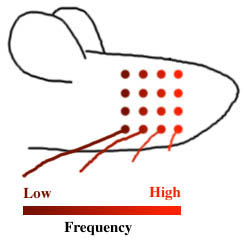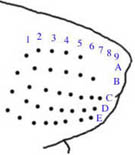The rat's whiskers are the first step in a highly sensitive sense of touch. Whiskers brush over the ground, obstacles, food, and other rats. When a whisker touches an object it bends, and when it bends its follicle sends a message to the rat's brain. The rats can tell the direction and how far each whisker moves. As the rat moves through the landscape he feels all the objects and textures near his face, and constructs an image of the world around him. This image may be far more detailed than what the rat can see through his eyes.
But that's not all whiskers do. Recent research has shown that the rat's whiskers may also be used in hearing.
|
|
|
Schematic drawing of whisker frequency map. Long whiskers that vibrate at low frequencies are located at the back of the array; short whiskers that vibrate at high frequencies are located at the front. Adapted from Andermann et al. 2004. |
|
|
|
Whiskers are organized in a grid with five horizontal rows and 5 to 9 columns (Vincent 1913) |
For example, whisker B2 vibrates at 182 Hz, a note between F and F# below middle C.
Whisker vibration may explain the extreme sensitivity of the rat's sense of whisker-touch. Rats can
make fine distinctions between different textures, like different grades of sandpaper. Rats may do this by sweeping
their whiskers over the sandpaper and feeling, not just the whiskers' overall displacement, but also the vibrations
of different whiskers. Coarse textures vibrate the longer whiskers, while fine textures vibrate the shorter ones.
The curled whiskers of rex rats probably don't resonate as well as straight whiskers. Therefore, rex rats probably do not 'hear' or distinguish different textures with their whiskers as well as normal rats.
If you enjoyed this page and would like to read more, visit:
- The world through a rat's whiskers
- What do rats hear?
- Journey into a rat's world: an introduction to the rat's senses

